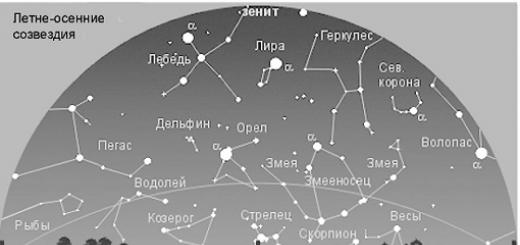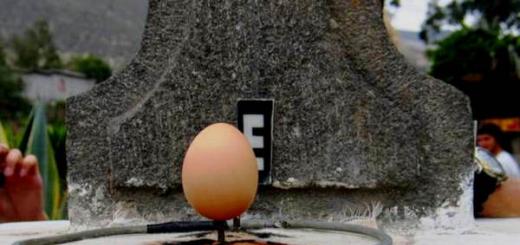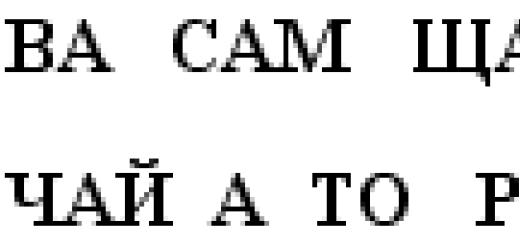| Analysis of the work | Answers |
|
| Pay attention to whether the tale has an author or whether it belongs to oral folk art. | ||
| Determine the type of this fairy tale (magic, everyday, about animals). Argument. | The type of this tale is "About Animals", since the main characters of this tale are animals. |
|
| Highlight the main plot elements of this tale (depending on the type). | Once upon a time there lived a cat, a goat and a ram in the same yard. - A cat, a goat and a ram ran for a long time through the dales, over the mountains, over loose sands; landed and decided to spend the night on a mowed meadow; and on that meadow there are haystacks that are cities. The old man and the old woman were glad, gladly, that the goat and the ram had returned home; and the purring cat was also torn out for trickery. |
|
| Name the heroes, list the main features of their character, the most significant actions. | Heroes: a cat, a goat, a ram, a bear, a pack of wolves, an old man and an old woman. Main characters: Cat: cunning, a thief and a robber, a good friend, resourceful, frivolous, wise. Act: Goat andram reliable friends, kind, obedient, reasonable. Act: |
|
| What words, phrases define the features of the language of this fairy tale (beginnings, repetitions, fixed epithets, small folklore genres)? You write. | Beginning: Once upon a time there lived a cat, a goat and a ram in the same yard. Replays: Cat-cat, gray pubis! Purring cat, gray forehead. Stable epithets: Cat-cat, cat-purr. |
|
| State the main idea of this story. In what phrase of the fairy tale is it expressed? What proverbs can convey it? | The main idea of this story: friendship, mutual assistance. They lived together: hay tuft and that in half; and if the pitchfork is in the side, then one cat Vaska. Proverbs: Look for a friend, and if you find - take care. Good conquers evil, and ingenuity triumphs over swindle. Live like a cat. |
|
| Name other fairy tales that are similar in plot, intent and character of the main characters. | Fairy tales: "Sister Chanterelle and the Gray Wolf". "Kids and the wolf". "The Fox, the Starling and the Crow". "The Fox and the Cat", etc. |
|
| Mark the main advantages of this fairy tale as a work for children's reading. | In my opinion, the main advantages of this fairy tale for children's reading is that friends will never leave you in trouble, but will always help; that for every bad deed there is a punishment. |
Independent work
according to MDK "Russian language with teaching methods"
"Analysis of the fairy tale" Rogue cat ""
Astrakhan, 2015
Konstantin Dmitrievich Ushinsky
rogue cat
I Once upon a time there was a cat, a goat and a ram in the same yard. They lived together: a bunch of hay and that in half; and if the pitchfork is in the side, then one cat Vaska. He is such a thief and a robber: where something lies badly, he looks there. Here comes a cat-purr, a gray forehead; goes so pitifully crying. They ask a cat a goat and a ram:
Cat-cat, gray pubis! What are you crying about, jumping on three legs?
Vasya answers them:
How can I not cry! A woman beat me, beat me; she tore out her ears, broke her legs, and even laid a noose on me.
And why did such trouble come to you? - ask the goat and the ram.
Eh-eh! For accidentally licking sour cream.
Serve the thief and flour, - says the goat, - do not steal sour cream!
The cat is crying again
A woman beat me, beat me; beat - she said: my son-in-law will come to me, where will I get sour cream? Involuntarily, a goat and a ram will have to be slaughtered.
A goat and a ram roared here:
Oh, you gray cat, your stupid forehead! Why did you ruin us?
They began to judge and decide how they could get rid of the great misfortune (avoid. Ed.), - and they decided right there: all three of them should run away. They lay in wait, as the hostess did not close the gate, and left.
II A cat, a goat and a ram ran for a long time through the dales, over the mountains, over loose sands; landed and decided to spend the night on a mowed meadow; and on that meadow there are haystacks that are cities.
The night was dark, cold: where to get fire? And the purring cat already took out the birch bark, wrapped the horns around the goat and ordered him to bang his foreheads with the ram. A goat and a ram collided, sparks fell from their eyes: the birch bark blazed.
Okay, - said the gray cat, - now let's get warm! - Yes, without thinking twice, he lit a whole stack of hay.
Before they had time to warm up properly, an uninvited guest, a gray-haired peasant, Mikhailo Potapych Toptygin, complained to them.
Let me go, - he says, - brothers, warm up and rest; something doesn't work for me.
Welcome, gray man! - says the cat. - Where are you going from?
I went to the bee-keeper, - says the bear, - to visit the bees, but I got into a fight with the peasants, that's why I pretended to be sick.
So they all began to while away the night together: a goat and a ram by the fire, a purr climbed onto the haystack, and the bear huddled under the haystack.
III The bear fell asleep; the goat and the ram doze; one purr does not sleep and sees everything. And he sees: there are seven gray wolves, one white - and straight to the fire.
Fufu! What a people! - says the white wolf to the goat and the ram. Let's try strength.
A goat and a ram bleated here with fear; and the cat, a gray forehead, led the following speech:
Oh, white wolf, prince above the wolves! Do not anger our elder: he, God have mercy, is angry! How it diverges - no one will do well. Al you do not see his beard: in it is all the strength; he beats all the animals with a beard, only removes the skin with his horns. It’s better to come up and ask with honor: we want to play with your little brother, who sleeps under a haystack.
The wolves on that goat bowed; surrounded Misha and, well, to flirt. Here Misha fastened, fastened, and how enough for each paw for a wolf, so they sang Lazarus (complained about fate. - Ed.). The wolves got out from under the haystack barely alive and, with their tails between their legs, - God bless!
The goat and the ram, while the bear dealt with the wolves, picked up the purr on his back and hurry home: "Enough, they say, without a way to drag, we will not make such a misfortune yet."
The old man and the old woman were glad, gladly, that the goat and the ram had returned home; and the purring cat was also torn out for trickery.
Lesson development (lesson notes)
Primary general education
Line UMK ed. L. A. Efrosinina. Literary reading (1-4)
Attention! The site administration site is not responsible for the content of methodological developments, as well as for the compliance of the development of the Federal State Educational Standard.
Lesson objectives
- - Cultivate love and kindness towards animals; - form the concepts of "kindness", "beauty", "respect", "mercy"; - acquaint with works of different genres (story, fairy tale); fairy tales, compare them, draw up a schematic plan for fairy tales and separate parts, retell according to a ready-made plan, compose small fairy tales with animal characters, find and read books about animals on your own, complete tasks on the topic of reading).
Activities
- - Draw up a schematic plan, retell according to the plan; - to tell a fairy tale or part of it close to the text; - choose books in the library on a given topic (about animals); - compose a homemade book about animal heroes; – know 3–5 names of authors who write about animals; - know by heart 1-2 poems on the topic of reading.
Key Concepts
- Genre, theme, author's fairy tale, K. Ushinsky
| № | Stage name | Methodological comment | |||||||||||||||
|---|---|---|---|---|---|---|---|---|---|---|---|---|---|---|---|---|---|
| 1 | 1. Identification of reading experience: test | - Guys, at home you should have read the work "Quail". Let's check how you read and remember it. - Performing interactive tasks. (When answering, students use the text of the work, read out sentences and excerpts from the text.) - And who is the author of the work “Lisa Patrikeevna”? (Konstantin Dmitrievich Ushinsky.) | |||||||||||||||
| 2 | 2. Enriching the reader experience: working with a new work | - Today we will get acquainted with the new work of Konstantin Dmitrievich "The Rogue Cat". Find it in the textbook. - Read the title. Is this a work of art or folk? Explain. - Listen. (While the teacher is reading the work, the students follow the text.) - Make a cover model. Examination. | |||||||||||||||
| 3 | 3. Enriching the reading experience: completing tasks in the textbook | – Dictionary work (interpretation of obsolete words and expressions). - Name the characters in the story. What is the name of the cat in the fairy tale? Read. - How do a goat and a ram address a cat when they pity him? Read. "What do they say when they're angry with him?" Read. - Who came to visit the cat, goat and ram? Read. How did the cat deceive the wolves? – Search for words and expressions that are found in other fairy tales. (Reading set expressions, repetitions, sayings.) | |||||||||||||||
| 4 | 4. Enriching the reader's experience: working with the text of the work | - Look at the illustrations. Find and read episodes that fit them. - Work in groups: reading the roles of each part of the tale. | |||||||||||||||
| 5 | 5. Enriching the reader's experience: working with the text of the work | - Rereading the fairy tale "The Rogue Cat" and drawing up a plan for the work. The teacher uses the interactive whiteboard and the students use the back of their papers to model. | |||||||||||||||
| 6 | 6. Generalization of the studied: working with models | Now look at the cover designs. Compare them. Select works for them. | |||||||||||||||
| 7 | 7. Generalization of the studied: comparison of works | - Comparison of the works of K. Ushinsky "The Rogue Cat" and K. Paustovsky's "Badger Nose". - Independent work of students to fill in the table.
|
|||||||||||||||
| 8 | 8. Recommendations for independent work at home (optional) | - Prepare an expressive reading of one of the parts of the fairy tale by K. Ushinsky “The Rogue Cat”. |
Once upon a time there lived a cat, a goat and a ram in the same yard. They lived together: a bunch of hay and that in half; and if the pitchfork is in the side, then one cat Vaska. He is such a thief and a robber: where something lies badly, he looks there. Here comes a cat-purr, a gray forehead; goes so pitifully crying. They ask a cat a goat and a ram:
Cat-cat, gray pubis! What are you crying about, jumping on three legs?
Vasya answers them:
How can I not cry! A woman beat me, beat me; she tore out her ears, broke her legs, and even laid a noose on me.
And why did such trouble come to you? - ask the goat and the ram.
Eh-eh! For accidentally licking sour cream.
Serve the thief and flour, - says the goat, - do not steal sour cream!
The cat is crying again
A woman beat me, beat me; beat - she said: my son-in-law will come to me, where will I get sour cream? Involuntarily, a goat and a ram will have to be slaughtered.
A goat and a ram roared here:
Oh, you gray cat, your stupid forehead! Why did you ruin us?
They began to judge and decide how they could get rid of the great misfortune (avoid. - Ed.), - and they decided right there: all three of them should run away. They lay in wait, as the hostess did not close the gate, and left.
A cat, a goat and a ram ran for a long time through the dales, over the mountains, over loose sands; landed and decided to spend the night on a mowed meadow; and on that meadow there are haystacks that are cities.
The night was dark, cold: where to get fire? And the purring cat already took out the birch bark, wrapped the horns around the goat and ordered him to bang his foreheads with the ram. A goat and a ram collided, sparks fell from their eyes: the birch bark blazed.
Okay, - said the gray cat, - now let's get warm! - Yes, without thinking twice, he lit a whole stack of hay.
Before they had time to get warm enough, an uninvited guest complained to them - a gray-haired peasant, Mikhailo Potapych Toptygin.
Let me go, - he says, - brothers, warm up and rest; something doesn't work for me.
Welcome, gray man! - says the cat. - Where are you going from?
I went to the bee-keeper, - says the bear, - to visit the bees, but I got into a fight with the peasants, that's why I pretended to be sick.
So they all began to while away the night together: a goat and a ram by the fire, a purr climbed onto the haystack, and the bear huddled under the haystack.
The bear fell asleep; the goat and the ram doze; one purr does not sleep and sees everything. And he sees: there are seven gray wolves, one white - and straight to the fire.
Fufu! What a people! - says the white wolf to the goat and the ram. - Let's try the force.
A goat and a ram bleated here with fear; and the cat, a gray forehead, led the following speech:
Oh, white wolf, prince above the wolves! Do not anger our elder: he, God have mercy, is angry! How it diverges - no one will do well. Al you do not see his beard: in it is all the strength; he beats all the animals with a beard, only removes the skin with his horns. It’s better to come up and ask with honor: we want to play with your little brother, who sleeps under a haystack.
The wolves on that goat bowed; surrounded Misha and, well, to flirt. Here Misha fastened, fastened, and how enough for each paw for a wolf, so they sang Lazarus (complained about fate. - Ed.). The wolves got out from under the haystack barely alive and, with their tails between their legs, - God bless!
The goat and the ram, while the bear dealt with the wolves, picked up the purr on his back and hurry home: “Enough, they say, without a way to drag, we’ll make such a misfortune yet.”
The old man and the old woman were glad, gladly, that the goat and the ram had returned home; and the purring cat was also torn out for trickery.
Once upon a time there lived a cat, a goat and a ram in the same yard. They lived together: a bunch of hay and that in half; and if the pitchfork is in the side, then one cat Vaska. He is such a thief and a robber: where something lies badly, he looks there. Here comes a cat-purr, a gray forehead; goes so pitifully crying. They ask a cat a goat and a ram:
- Cat-cat, gray pubis! What are you crying about, jumping on three legs?
Vasya answers them:
How can I not cry! A woman beat me, beat me; she tore out her ears, broke her legs, and even laid a noose on me.
“And why did such trouble come to you?” - ask the goat and the ram.
— Eh-eh! For accidentally licking sour cream.
- Serve the thief and flour, - says the goat, - do not steal sour cream!
The cat is crying again
- The woman beat me, beat me; beat - she said: my son-in-law will come to me, where will I get sour cream? Involuntarily, a goat and a ram will have to be slaughtered.
A goat and a ram roared here:
- Oh, you gray cat, your stupid forehead! Why did you ruin us?
They began to judge and decide how they could get rid of the great misfortune (avoid. Ed.), And they decided right there: all three of them should run away. They lay in wait, as the hostess did not close the gate, and left.
A cat, a goat and a ram ran for a long time through the dales, over the mountains, over loose sands; landed and decided to spend the night on a mowed meadow; and on that meadow there are haystacks that are cities.
The night was dark, cold: where to get fire? And the purring cat already took out the birch bark, wrapped the horns around the goat and ordered him to bang his foreheads with the ram. A goat and a ram collided, sparks fell from their eyes: the birch bark blazed.
- All right, - said the gray cat, - now let's warm up! - Yes, without thinking twice, he lit a whole stack of hay.
Before they had time to warm up properly, an uninvited guest, a gray-haired peasant, Mikhailo Potapych Toptygin, complained to them.
“Let me in,” he says, “brothers, to warm up and rest; something doesn't work for me.
- Welcome, little man! - says the cat. - Where are you going from?
- I went to the bee-keeper, - says the bear, - to visit the bees, but I got into a fight with the peasants, that's why I pretended to be sick.
So they all began to while away the night together: a goat and a ram by the fire, a purr climbed onto the haystack, and the bear huddled under the haystack.
The bear fell asleep; the goat and the ram doze; one purr does not sleep and sees everything. And he sees: there are seven gray wolves, one white - and straight to the fire.
- Fu-fu! What a people! - says the white wolf to the goat and the ram. Let's try strength.
A goat and a ram bleated here with fear; and the cat, a gray forehead, led the following speech:
- Oh, you white wolf, the prince above the wolves! Do not anger our elder: he, God have mercy, is angry! How it diverges is not good for anyone. Al you do not see his beard: in it is all the strength; he beats all the animals with a beard, only removes the skin with his horns. It’s better to come up and ask with honor: we want to play with your little brother, who sleeps under a haystack.
The wolves on that goat bowed; surrounded Misha and, well, to flirt. Here Misha fastened, fastened, and how enough for each paw for a wolf, so they sang Lazarus (complained about fate. - Ed.). The wolves got out from under the haystack barely alive and, with their tails between their legs, - God bless!
The goat and the ram, while the bear dealt with the wolves, picked up the purr on his back and hurry home: “Enough, they say, without a way to drag, we’ll make such a misfortune yet.”
The old man and the old woman were glad, gladly, that the goat and the ram had returned home; and the purring cat was also torn out for trickery.
Target: To acquaint children with the fairy tale of K. Ushinsky “The Rogue Cat” and analyze it.Tasks:
to form reading skills (read, work with the text of the work, correctly name the work, determine the topic and genre);
contribute to the enrichment of the vocabulary of the language of children;
observe the expressive means of the language;
by means of the lesson to educate students in self-confidence;
develop elements of project activities.
Textbook L.A. Efrosinina “Literary reading Grade 2”
Workbook L.A. Efrosinina “Literary reading grade 2” part 2
Sheets for making model covers, colored pencils.
Presentation for the lesson.
Organizing time
One, two, three, four, five
Pens, books and notebooks
Everything is fine with us.
Who is much more literate, that will not be an abyss.
(Students in chorus pronounce the “call” by touching the objects on the table.)
Free reading with intermediate measurement of reading technique.
Raise your hand, who has improved reading technique? Why do you think? What advice can you give to classmates?
3. Repetition of the past.
- What section are we studying? Works about animals.
Look at the cover schemes and name which works we have studied in this section fit these models. (on the slide cover models for the genres of "story" and "poem").
SLIDE
Zhukovsky "Bird"
Russian folk song
"Burenushka"
Ushinsky "Cat Vaska"
Prishvin "Old Mushroom"
Ushinsky "Lisa Patrikeevna"
Bianchi "Hedgehog Savior" (poetry)
The task is performed on the interactive whiteboard.
What is our favorite genre to add a cover model to? (To the genre of "fairy tales").
D/Z check
Is this a normal poem? How else can you call it? (Saying)
Which fairy tale is this story suitable for?
4. Updating the topic of the lesson.
- Now we will check how well you know fairy tales.
Guess the story by its beginning. If the story has an author, name it.
a) "Here's what, sons: take an arrow, go out into an open field and shoot: where the arrows fall, there is your fate" (Princess Frog)
b) It was winter. It was the month of January. In the evening, the evil stepmother opened the door, looked at how the blizzard was blowing, and then returned to the warm stove and said to her stepdaughter: “You should go to the forest, pick up snowdrops there” ” (“Twelve months” - S. Marshak)
c) Santa Claus read the letter and said:
Why so late? You, Snowman, will not have time to bring a Christmas tree to the guys for the New Year.
("Yolka" E. Suteev.)
d) “The old man, leaving, ordered the rooster to take care of the house and not look out the window. But the fox painfully wanted to eat the cockerel.
("Cat, Rooster and Fox")
And now we will find out how carefully you read fairy tales.
On what or on whom did these heroes travel?
a) Dunno with friends in Green City? (on the air balloon)
b) Baby on the roof ? (on Carlson)
c) Dr. Aibolit to Africa? (on the ship)
d) Baby Niels in Sweden (on goose)
5. Reporting the topic and objectives of the lesson.
- You have shown yourself to be good connoisseurs of fairy tales, today we will replenish our knowledge, get acquainted with another fairy tale written by Konstantin Dmitrievich Ushinsky, and it is called “The Rogue Cat”. In the course of work, we will enrich our vocabulary, observe the expressive means of the language, and improve our reading skills.
And most importantly, we must find the answer to the main question of the lesson “What does the read work teach us, why did the authors include it in their textbook?”
SLIDE
K. D. Ushinsky?
Konstantin Dmitrievich Ushinsky was born on February 19 in the family of a retired officer, his mother died when he was 12 years old. Konstantin Dmitrievich successfully graduated from the gymnasium and the law faculty of Moscow University. He taught at the Institute of Noble Maidens in Smolny, published pedagogical journals, wrote textbooks, was a teacher of teachers, a writer, and a philosopher. A medal named after K. D. Ushinsky was established, which is awarded to the best teachers.
Today we will get acquainted with the fairy tale, which was included in his textbook "Native Word".
6. Listening to the piece.
Music sounds, allowing students to plunge into the world of fairy tales.
Why is the cat in the fairy tale called a "rogue"?
The teacher reads, the children read well.
Identification of primary perception.
SLIDE
What do you think, which of these little men could read this fairy tale? Why?
So why is the cat in the fairy tale called a "rogue"?
Which of you remember the heroes of the work? (cat, goat, ram, bear, wolves, old man and old woman).
Which of them can we call the main characters and why? (cat, goat and ram).
8. Vocabulary work.
SLIDE.
How do you understand words and expressions?
Judge and judge.
Ran through the valleys.
Birch bark.
The sickness pretended.
“It’s enough to drag around without a way, we’ll make such a misfortune yet.”
Open page 22, find the heading "Glossary". Read the explanation, the interpretation of incomprehensible words. Most recently, in a Russian language lesson, we learned what the lexical meaning of a word is. What is the name of the dictionary where the lexical meaning of words is given?
Complete task number 1 in notebooks on a printed basis p.15. (How else can you say it? Write it down.)
Examination.
Work with the text of the listened work.
We are now rereading the story. The first group of guys, those who sit in the front row, will find and underline the sentences that characterize the cat. The second group - the second row, will find and underline sentences that characterize the goat and the ram. The third group will think about how to complete the diagram (slide on the board).
what started the events
how did events develop?
how did the story end?
developments
? ?
start of events end of events
Fizkultminutka.
After reading the text, students answer questions and complete the diagram.:
a) selective reading.
Students restore chains and diagram
Let's try to restore the schema:
Travel hazards
developments
forced escape homecoming
start of events end of events
PAGE ON INTERACTIVE BOARD.
the cat is a thief and a robber, a good friend, resourceful, frivolous, wise.
Name the good qualities of a cat, the bad ones. Who is meant by a cat in a fairy tale?
What qualities of character do you value in yourself, and which ones would you like to get rid of?
The goat and the ram are reliable friends, kind, obedient, reasonable.
Support your answer with sentences from the text.
Which of the characters did you like? Why?
What helped us to imagine the heroes of the fairy tale more vividly, to understand their character? (language of a fairy tale, artistic techniques).
c) restoring deformed text
PAGE ON INTERACTIVE BOARD. Simultaneously with the work at the blackboard, students complete the task in notebooks on a printed basis. (Task number 3 p. 15)
He sleeps in a lair spring
Under the great winter
And when the pine comes
Wakes up from sleep.
He sleeps in a den in winter
Under the great pine
And when spring comes
Wakes up from sleep.
- Write down the answer in your notebook and complete the following task
(Task number 4 p. 15)
Examination. Before they had time to get warm enough, an uninvited guest complained to them - Mikhailo Potapych Toptygin
10. Observe the expressive means of the language.
How is cat stealing described? (What lies badly, looks there.)
How does the fairy tale say about the punishment of the cat? (Pitchfork to the side, tore out her ears, broke her legs, saved the noose)
What is the name of the cat in the fairy tale? (cat, purr, kitty)
How does a goat and a ram turn to a cat when they pity him? Angry? Try to voice it. (Cat-cat, gray pubis. You are a gray cat, your stupid forehead.)
- Read the beginning of part 3.
- What did the white wolf offer the goat and the ram?
/ try the force/
How did the goat and the ram behave?
/Frightened/
And the cat is a gray forehead?
/ He decided to cheat, deceive /
He deceived, the wolves approached Misha. Read how Misha dealt with uninvited guests.
/Here Misha fastened, fastened, but as soon as there was enough for each paw of a wolf, so they sang Lazarus./
How is it "a wolf for each paw." Show.
Remember what it means to sing Lazarus.
/Complain, cry, moan./
How did the fairy tale end? Read.
/... and the cat - the purr was torn out for trickery. /
- How did the goat respond to the cat's complaint when he was beaten? (Serve the thief and flour.)
Can these words be called a proverb, folk wisdom?
11. Differentiated work.
PAGE ON THE INTERACTIVE WHITEBOARD
a) Read the proverbs.
B) Choose a proverb that fits the fairy tale.
Look for a friend, and you will find - girebe.
Friendly - not heavy, but apart - quietly osbr.
Live like a poop.
Two boots - brine.
12. Modeling the cover.
- Let's make a cover model.
- What did you listen to? Define the genre. Show on the model. /Fairy tale/
- What or who is this story about? Show on the model. /Brown color/
What title did the author choose for his work? /Rogue cat/
What is the name of the work? /Fairy tale about animals of Ushinsky “The rogue cat”/
13. The result of the lesson.
Can we now answer the main question of the lesson
“What does the read work teach us, why did the authors include it in their textbook?”
14. Homework.
Read this story to your parents again at home. On the reverse side of the sheet with the cover model, draw how do you imagine the main character?.
Finish your notebook.
In the next lesson, when checking D / Z, we will make a homemade book with you for your class library.
/ A book is assembled from the pages of children - a homemade book with a cover made by a teacher. /










